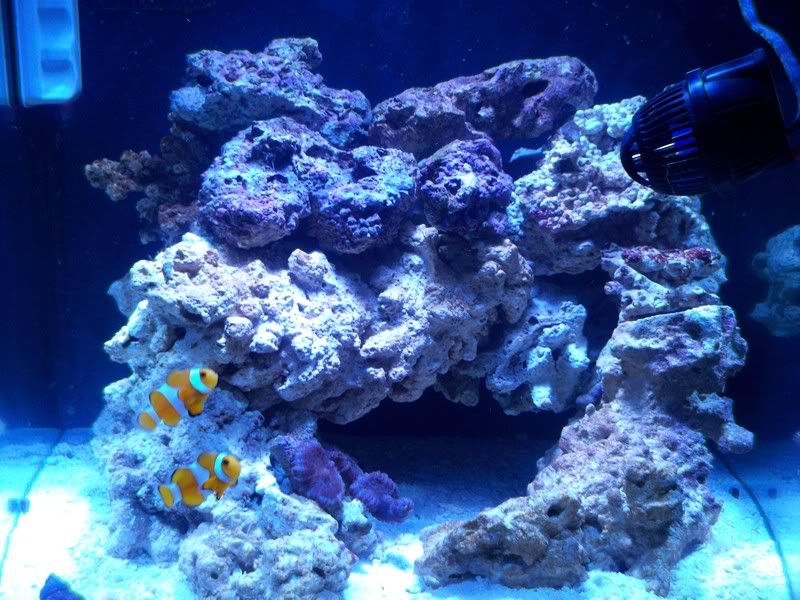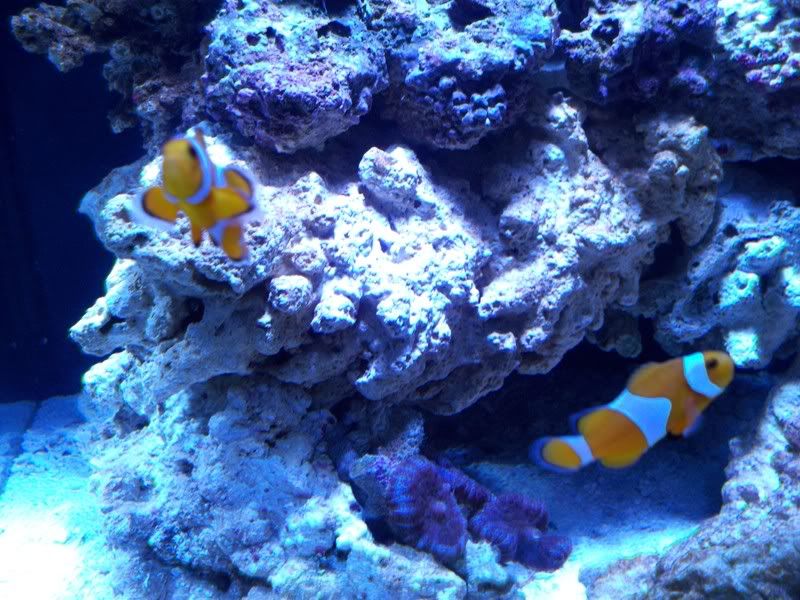Nano Reefers! Info and Tank Photos!
- Thread starter nissan577
- Start date
subielover
Active Member
Is that LMB in a 14 gallon???
 I was under the impression that they needed a larger tank and that they grew to about 6 inches. Am I wrong?
I was under the impression that they needed a larger tank and that they grew to about 6 inches. Am I wrong?

spanko
Active Member
Originally Posted by subielover
http:///forum/post/2818317
Is that LMB in a 14 gallon???
 I was under the impression that they needed a larger tank and that they grew to about 6 inches. Am I wrong?
I was under the impression that they needed a larger tank and that they grew to about 6 inches. Am I wrong?
Well most sites say a minimum 30 gallon tank. They do get to 5-6 inches in the wild, not sure how big in our tanks. If he is a small one in SD's tank he should be okay for a while.
http:///forum/post/2818317
Is that LMB in a 14 gallon???

Well most sites say a minimum 30 gallon tank. They do get to 5-6 inches in the wild, not sure how big in our tanks. If he is a small one in SD's tank he should be okay for a while.
subielover
Active Member
Originally Posted by SilverDak
http:///forum/post/2818356
nah he will be fine
Did you see it eat at the lfs?
http:///forum/post/2818356
nah he will be fine
Did you see it eat at the lfs?
subielover
Active Member
I love nanos!!!
subielover
Active Member
I was thinking about one because of my algae problem as well, then the lfs owner showed me her 7" lmb, looked like a freaking eel. I went with a bicolor after seeing that


silverdak
Active Member
i didnt mean it in the way of having a shark in a fish tank.. duh thats not gonna work... you can fit a LMB in a 14G no problems, there growth will be slightly stunted.. also when it says they can grow to be 7 inches or whatever.. your reading in the wild right?? not gonna be the same as captive ones
spanko
Active Member
Okay SD you are making this harder than it should be. Being in a smaller tank will not stunt the growth of a fish significantly, this is s myth, and even if it did the fish would still be stressed and subject to lowered immunity and problems associated with that. This fish will continue to grow with available food and are known to be a bit testy when they get bigger. That all said, again, if it is small now it may be good for sometime, just keep and eye on things.
nano-newb1983
Active Member
updated pics:




silverdak
Active Member
Originally Posted by spanko
http:///forum/post/2818881
Okay SD you are making this harder than it should be. Being in a smaller tank will not stunt the growth of a fish significantly, this is s myth, and even if it did the fish would still be stressed and subject to lowered immunity and problems associated with that. This fish will continue to grow with available food and are known to be a bit testy when they get bigger. That all said, again, if it is small now it may be good for sometime, just keep and eye on things.
 fine I will just go with that for a while lol I have seen it both ways.. I am done, I have a LMB in my tank, good or bad it was my call and that's what I decided... I mean its not like I put a Bamboo shark in a 14G or anything geez
fine I will just go with that for a while lol I have seen it both ways.. I am done, I have a LMB in my tank, good or bad it was my call and that's what I decided... I mean its not like I put a Bamboo shark in a 14G or anything geez

http:///forum/post/2818881
Okay SD you are making this harder than it should be. Being in a smaller tank will not stunt the growth of a fish significantly, this is s myth, and even if it did the fish would still be stressed and subject to lowered immunity and problems associated with that. This fish will continue to grow with available food and are known to be a bit testy when they get bigger. That all said, again, if it is small now it may be good for sometime, just keep and eye on things.


subielover
Active Member
Love the pics man, great job.
spanko
Active Member
Okay here is my last post on the subject. A qoute from Bob Fenner.
"Selection:
As with most territorial fish species, these blennies are best purchased small, and placed near last to provide your best chance at establishing a livable pecking order. How small is small? Two inches for Atrosalarias, two and a half to three maximum for Salarias spp.
Take care to not purchase a "too-thin" specimen that has been on hand and starved for too long, but on the other hand, don't be too anxious to acquire a just arrived individual either. Ones that are going to "die mysteriously" do so most often in the first few days of arrival.
Torn fins are not indicative of a doomed specimen, as these blenniids are rapid healers. Cloudy eyes, missing scales, sores on the body would disqualify a purchase however. Do watch/observe carefully for active, inquisitive behavior, hallmarks of a winning specimen.
Captive Habitat:
Expanding on the above environmental conditions, the size, maturity of a given system intended for these fishes is paramount in determining your successfully keeping them. Even starting with the smaller Atrosalarias fuscus or a very small specimen, a minimum of an undercrowded sixty gallons with this or more pounds of matured live rock is suggested. As you will find, these species claim an easy equivalent of bottom space as their own as this... With a hundred gallons per for a full size (five inch or so) Salarias fasciatus, being about right.
Tankmates:
These are by nature territorial fishes, that will drive out other animals, including of their own kind, from their algal patch area... how to put this.... with extreme prejudice. Algae eating tangs like Ctenochaetus, many Zebrasoma, small Rabbitfishes/Spinefoots... sessile invertebrates that make their living rasping the bottom, may have a tough go at living in the same small space as these blennies. If you would like to try mixing them, do place the blenny last.
Other blennies/oids and families of fishes are generally ignored, or just chased for the halibut by algae blennies, as long as their not filamentous algae eaters. "
"Selection:
As with most territorial fish species, these blennies are best purchased small, and placed near last to provide your best chance at establishing a livable pecking order. How small is small? Two inches for Atrosalarias, two and a half to three maximum for Salarias spp.
Take care to not purchase a "too-thin" specimen that has been on hand and starved for too long, but on the other hand, don't be too anxious to acquire a just arrived individual either. Ones that are going to "die mysteriously" do so most often in the first few days of arrival.
Torn fins are not indicative of a doomed specimen, as these blenniids are rapid healers. Cloudy eyes, missing scales, sores on the body would disqualify a purchase however. Do watch/observe carefully for active, inquisitive behavior, hallmarks of a winning specimen.
Captive Habitat:
Expanding on the above environmental conditions, the size, maturity of a given system intended for these fishes is paramount in determining your successfully keeping them. Even starting with the smaller Atrosalarias fuscus or a very small specimen, a minimum of an undercrowded sixty gallons with this or more pounds of matured live rock is suggested. As you will find, these species claim an easy equivalent of bottom space as their own as this... With a hundred gallons per for a full size (five inch or so) Salarias fasciatus, being about right.
Tankmates:
These are by nature territorial fishes, that will drive out other animals, including of their own kind, from their algal patch area... how to put this.... with extreme prejudice. Algae eating tangs like Ctenochaetus, many Zebrasoma, small Rabbitfishes/Spinefoots... sessile invertebrates that make their living rasping the bottom, may have a tough go at living in the same small space as these blennies. If you would like to try mixing them, do place the blenny last.
Other blennies/oids and families of fishes are generally ignored, or just chased for the halibut by algae blennies, as long as their not filamentous algae eaters. "
subielover
Active Member
I love nanos!!!

